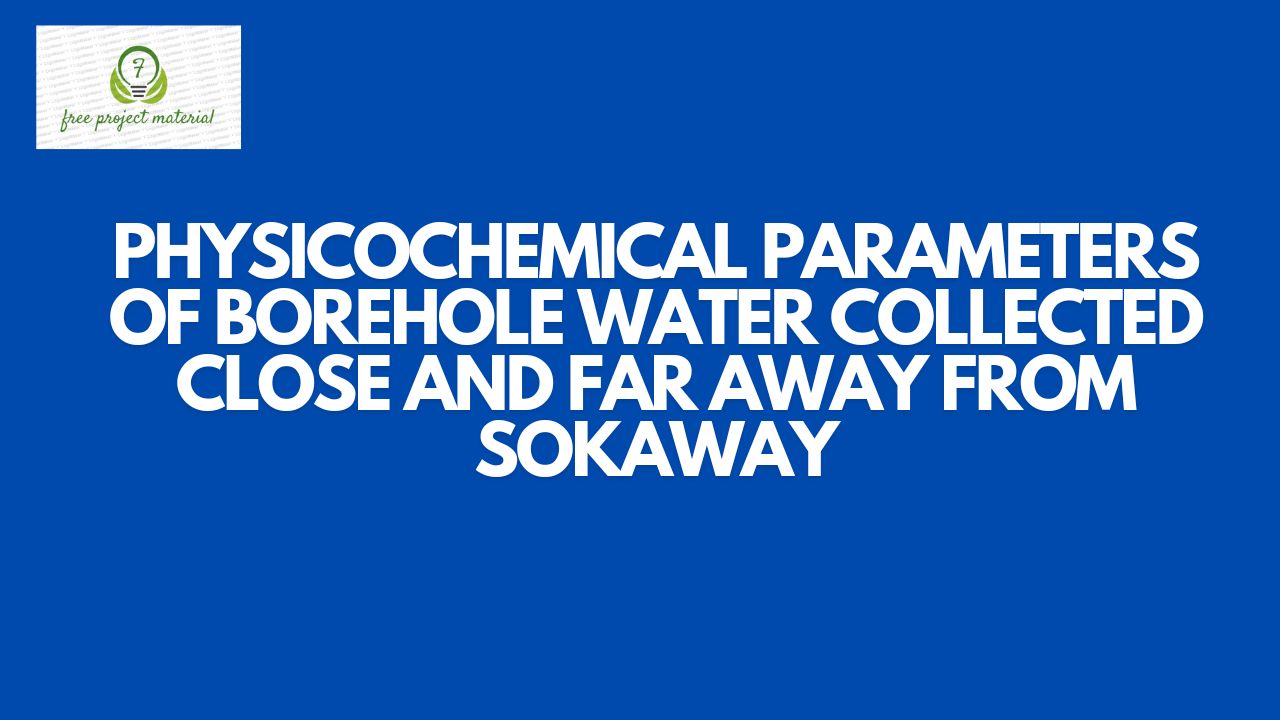ABSTRACT
The study on the physicochemical parameters of borehole water collected close and far away from soakway was carried out using standard analytical methods. The result of the study revealed that the values obtained were higher in the water sample obtained close to soakaway than the sample collected far away from soakaway. Although some of the parameters in the sample were within the WHO permissible limit, such as electrical conductivity, pH, appearance and TSS. Others exceeded the WHO permissible limit, which could have been due to the fact that the soakaway is to some extent shielded from the surrounding environments. But the water sample collected at far distance from soakaway had its physicochemical parameters within the WHO permissible limit, which suggest that it is fit for consumption. However, from the result obtained in this study siting borehole close to soakaway/septic tank is not advisable as this could cause the contamination of the surrounding water and consequently the borehole water. Thus, it recommended that Siting of bore hole close to soakaway should be prohibited since this has the potential to pollute the surrounding ground water resulting in the direct pollution of the borehole water.
TABLE OF CONTENTS
Pages
Title page – – – – – – – – – i
Certification – – – – – – – – ii
Dedication – – – – – – – – – iii
Acknowledgments – – – – – – – – iv
Abstract – – – – – – – – – v
Table of contents – – – – – – – vi
CHAPTER ONE
INTRODUCTION
1.1 Background of the Study – – – – – 1
1.2 Aims and Objectives of the Study – – – – 3
1.3 Scope and Limitations of the Study – – – – 4
1.4 Definition of Terms – – – – – – 4
CHAPTER TWO
LITERATURE REVIEW
2.1 Water – – – – – – – – – 6
2.1.1 Qualities of Water – – – – – – 7
2.1.2 Water and its relation to health – – – – 8
2.1.3 Factors Affecting Water Quality – – – – 8
2.2 Groundwater Source – – – – – – 10
2.3 Groundwater Source and Protection – – – – 10
2.4 Management of water use – – – – – – 11
2.5 Environmental Health – – – – – – 12
2.6 Environmental Hazards – – – – – – 14
2.6.1 Environmental Health – – – – – – 16
2.7 Soakaway Systems – – – – – – – 15
CHAPTER THREE
MATERIALS AND METHOD
3.1 Materials – – – – – – – – 16
3.2 Sample Collection – – – – – – – 17
3.3 Determination of Physiochemical Parameters
of Water Sample – – – – – – – 17
3.3.1 Determination of Temperature – – – – – 17
3.3.2 Determination of Conductivity – – – – 17
3.3.3 Determination of pH – – – – – – 18
3.3.4 Determination of Total Dissolving Substance – – 18
3.3.5 Determination of Acidity (PA) – – – – – 19
3.3.6 Determination of Alkalinity – – – – – 19
3.3.7 Determination of SO-2 – – – – – 20
3.3.8 Determination of NO3 – – – – – – 20
3.3.9 Determination of Biochemical Demand (BOD) – – 20
CHAPTER FOUR
RESULT AND DISCUSSION
4.1 Result – – – – – – – – 21
4.2 Discussion – – – – – – – – 22
CHAPTER FIVE
SUMMARY, RECOMMENDATION AND CONCLUSION
5.1 Conclusion – – – – – – – – 27
5.2 Recommendations – – – – – – – 28
References
CHAPTER ONE
1.0 INTRODUCTION
1.1 Background of the Study
Water is one of the basic necessities for the sustenance of life, and it impacts nearly all areas of life. Water quality and the risk to water-borne diseases are critical public health concerns in many developing countries. It has been reported that about billion people mostly living in the developing world does not have access to safe and adequate water (UNICEF/W.H.O., 2012).
Contamination of water bodies has increasingly become an issue of serious environmental concern. Clean water is a priceless and limited resource that man has begun to treasure only recently after decades of pollution and waste (Silberberg, 2003). Portable water is an essential ingredient for good health and the socio-economic development of man but it is lacking in many societies (Udom et al., 2002).
All Natural waters contain many dissolved substances. Contaminants such as bacteria, viruses, heavy metals, nitrates and salt have polluted water supplies as a result of inadequate treatment and disposal of waste from humans and livestock, industrial discharges and over-use of limited water resources (Singh and Mosley, 2003).
To avoid groundwater pollution from effluent leachate, the community water and sanitation Agency (CWSA) recommends that pit latrines should be constructed at least 100 feet (30m) downhill of boreholes (CWSA, 2003). In addition, W.H.O. (2006) asserted that a minimum of 50 feet (15m) between a pollution source and downstream water abstraction point will be satisfactory.
Water must be assessed before it is used for drinking, domestic, agricultural or industrial purposes. This is mostly done with different physicochemical parameters, which mostly depend on the purpose of the water and the extent to which the quality and purity is required (Umar et al., 2003). Water has different types of physical, chemical and biological impurities. These require different tests to determine the level of these contaminants in the water. To obtain water of good quality, it should be tested for trace metals, heavy metals, organic materials and biological contaminants. For water to be considered as good for drinking then it should pass all these tests and it should also contain required amount of mineral level (Umar, 2006). Previous studies on boreholes water from Kano, (Saeed and Mahmoud, 2014) had reported that, most of the physicochemical parameters analysed were within the maximum permissible limit set by W.H.O. (2020). This work therefore assesses the comparative analysis of physicochemical parameters of borehole water constructed near and far away from soakaway.
1.2 Aim and Objectives of the study
The aim of this study is physicochemical parameters of borehole water constructed near soakway and water from non-soakaway area.
The objectives of this study are:
(1) To determine the physical parameters of water from Borehole water near soakaway or septic tank
(2) To determine the chemical parameters of borehole water cited near soakaway
(3) To determine the chemical and physical parameters of borehole water cited in area outside the perimeters of soakaway.
1.3 Scope and Limitation of the Study
This study focused on assessing the physicochemical parameters of borehole water constructed near septic tank. This study is only limited to Ikot Ekpene metropolis, this is due to time and financial constraints.
1.4 Definition Terms
Water: it is colourless, transparent, odourless liquid that forms the seas, lakes, rivers and rain and it is the basis of the fluid of living organism.
Sachet water: it is the water that is packaged using cellophane paper and it is the major source of drinking water.
Potable water: it is water that is considered safe to drink that has meet up the standard requirement for human consumption.
Physiochemical Properties: it consist of two characteristic which are the physical and chemical behaviours of the water sample.
Borehole: a deep, narrow hole made in the ground, especially to locate water or oil.
Septic Tank: a tank, typically underground, in which sewage is collected and allowed to decompose through bacterial activity before draining by means of a soakaway.


